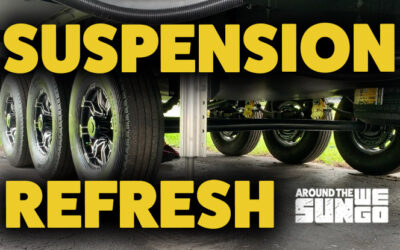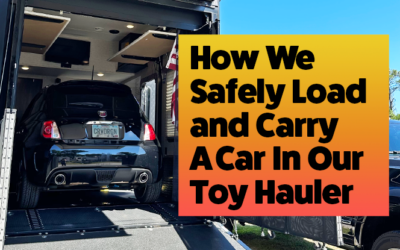In previous videos I’ve explained why we chose a 5th wheel RV, why we liked the Grand Design 397TH floorplan and more. If you haven’t seen those yet you can check them out here: https://rebrand.ly/4176ayd
In today’s installment I’m going to explain how we determined what type of truck we needed to tow our massive RV.
SAFETY, SAFETY, SAFETY
From the start, our number one priority when picking out a truck was safety. Safety of our lives, safety of everyone on the road around us, and then also the safety of our equipment. This was going to be our only home for the foreseeable future and we wanted to make sure it was safe and secure even as we travelled at highway speeds all over the entire country.
And the biggest threat to that safety was the massive amount of weight we would be hauling.
Where Did We Start?
There were two basic weight numbers I needed from the RV in order to determine which trucks could safely tow it.
1. GVWR (Gross Vehicle Weight Rating)
The Gross Vehicle Weight Rating or GVWR which is the absolute maximum the entire RV is ever allowed to weigh, including all payloads.
So that includes the RV itself, all of the furniture and appliances, any modifications we want to add to it, all of our clothes and tools, any supplies we want to bring along, any water in the tanks, the weight of the vehicle loaded in the back, etc.
2. Pin Weight
The Pin Weight is the amount of weight that presses down on the bed of the truck. So the question was, how many pounds of force would be resting on the hitch in the truck bed, and therefore resting on the frame and suspension of the truck?
Towing Guides
Grand Design listed the Gross Vehicle Weight Rating of our 397TH at 20,000 pounds and the pin weight at around 3500 pounds.
Now that I knew these numbers, I started the process of elimination by looking at the official towing guides from the top three truck manufacturers, Ford, Ram and Chevy.
I was able to find all of these on Google but you can also find the most recent ones here:
Ford – https://rebrand.ly/igvkowb
Ram – https://rebrand.ly/sxqe2j3
Chevy – https://rebrand.ly/s297ywo
The 20,000 pound GVWR of our 397TH immediately eliminated all 150s, 250s, 1500s and 2500s across all brands.
So at this point I knew the only trucks rated to pull our trailer were the diesel versions of the Ram 3500, Chevy 3500 and Ford F-350 & 450.
SRW vs DRW (Single Rear Wheel vs Dual Rear Wheel)
The next thing we needed to figure out is if we wanted a single rear wheel setup or a dual rear wheel. This is where the Pin Weight comes into play.
According to the towing guides, all single rear wheel options seemed to be borderline capable at best, across every brand. Was it possible to tow without a dually? Sure. But it wouldn’t be the safest setup we could get. We’d lose some stability in high winds and during emergency maneuvers. And if we ever had a rear wheel blowout, it could be catastrophic.
Plus, the single wheel setups offered absolutely no wiggle room when it came to payload capacity. So we wouldn’t have a lot of freedom to add weight with any modifications we might want to do or by carrying extra fuel or cargo in the truck with us on travel days.
So with all that considered, we knew at this point we were going to go with a dually.
OTHER FACTORS
Now that we knew all of these models could safely tow the rig, our next step was to eliminate based on other factors. Warranties were the same across the board. Reputations were similar. Prices were similar.
So it then boiled down to convenience features and looks.
From the very beginning my top pick was Ford, based purely on looks.
But as I dug deeper, I realized Ford was also the only brand at the time that offered a 360-degree camera system with the bird’s-eye-view feature.
In early 2019, none of the other brands offered this tech yet and considering this was pretty much the largest vehicle I’d ever driven, and we’d be taking it all over the country into places I’d never been, and we’d be navigating it through tight campgrounds and cities on a regular basis, it was hard to justify passing that up.
So in the end, looks and tech are what eliminated everything except the Ford F-350 and 450.
F-350 VS F-450
As I compared the differences between these two, I initially found some confusing info. It appeared that although the 450 had beefier brakes, axles, tires and a higher-torque rear axle ratio, it had less payload capacity than the 350, which made no sense to me.
But after researching a little deeper I found a reason for this. Ford has essentially “de-rated” the 450, at least on paper, down to a 14,000 pound GVWR because anything above 14,000 pounds is considered a Class 4 truck, which enters commercial territory. So that means more expensive vehicle registrations and higher insurance costs for the consumer.
To get around this, Ford simply markets the 450 as a Class 3 consumer grade truck, even though in reality, it’s closer to a commercial grade Class 4. And because the components are beefier, they weigh more, and that extra weight is subtracted from the 14,000 GVWR, leaving the 450 with a lower payload capacity than the lighter 350. So a bit misleading at first, but all things considered, it appeared to me that for a little extra money, you could get a lot more truck in the 450.
The 450 also had a wider front end, which not only looked more aggressive and balanced, but also gave the wheels more room to turn, meaning a tighter turn radius.
So the 450 definitely seemed like our best option, but before making a final choice we decided to test drive both.
Test Drive
We found a dealer with a 350 pretty close to us so we tried that out first and absolutely loved it.
Amazing interior. Quiet, comfortable and smoother than we expected for such a large and heavy tow-optimized vehicle. Once we were back at the dealership, I tried a full 180-degree turn to check out the turn radius and it WAS pretty wide.
I knew the 450 would be better, but considering I’d never driven a 22 foot dually before, I figured either way, this was probably the nature of the beast and I’d eventually get the hang of it.
Then we drove a few hours away to test drive a 450, and we were absolutely blown away. The difference in turn radius was insane. It felt tighter than any vehicle I’d ever driven, period, and we were both super hype about this fact. So that made the 450 a no brainer for us.
Configuring & Ordering
I then went to Ford.com and built out the exact truck we were wanting, picking and choosing each and every feature. Our initial plan was to custom order the truck from the factory, just like we’d done with the RV, but I noticed there were two black F-450 Platinums within a couple hundred miles of us that had pretty much everything we wanted.
Since these were already on the lot and the dealers needed to move them anyway, I figured I’d be able to negotiate a better price on those than I could if I custom ordered.
And that’s what we ended up doing. With a few emails I started the bidding war between the two dealers until we got to the rock bottom price and then we went with the winner, shaving over $6200 off the MSRP.
We put down a deposit over the phone and then drove a few hours to pick it up.
Accessories & Modifications
Our next step was to figure out exactly what accessories and modifications we needed to add to the truck to make it the perfect full-time tow rig. Make sure to subscribe here because I’ll cover that next.
To make things easier to follow along with, I created a video playlist that covers each step we took, in chronological order, as we built out our full-time setup. You can find it on my YouTube channel homepage or by clicking here.
🔗 LINKS 🔗
VIDEO LINKS PLAYLIST – BUILDING OUR FULL TIME RV SETUP
AFFILIATE STORE – PRODUCTS & GEAR WE RECOMMEND
MERCH COLLECTION – HATS AND TEES
FREE VIDEO COURSE – HOW I QUIT MY JOB AND WORK FROM ANYWHERE
SUBSCRIBE TO MY YOUTUBE CHANNEL
Camera Gear Used In This Video
Panasonic GH4 Camera Body – https://rebrand.ly/alhkrti
7.5mm Lens – https://rebrand.ly/vhtm769
Tripod – https://rebrand.ly/8pwpcxj
Tripod Head – https://rebrand.ly/1fq74b0
Wireless Mic System – https://rebrand.ly/4i0e01g
4.5mm Mic Clip – https://rebrand.ly/v9vs09p
Camera Stabilizer / Gimbal – https://rebrand.ly/xnuljsv
Osmo Pocket Gimbal Camera – https://rebrand.ly/qkbad7y
4k Drone – https://rebrand.ly/f10c0pv
Drone Lens Filters – https://rebrand.ly/fq9njr3
GoPro Black – https://rebrand.ly/pq9u9b8
Front & Interior Dash Cam – https://rebrand.ly/vlflie4
Other Items Appearing In This Video
Day One RV Necessities – https://rebrand.ly/g6saull
Safety Items – https://rebrand.ly/uumcze1
Wireless RV Backup Camera – https://rebrand.ly/yofkh4z
RV GPS Navigation Unit – https://rebrand.ly/vojgxz3
Tire Pressure Monitor System – https://rebrand.ly/yqu435e
F-450 Front Bike Rack – https://rebrand.ly/rpknwe7
F-450 2” Front Mount Hitch – https://rebrand.ly/pp4d72z
Front & Interior Dash Cam – https://rebrand.ly/vlflie4
Fuel Tank Tool Box – https://rebrand.ly/r4tyxnn
Two-Way Weather Radios – https://rebrand.ly/gqa2ad7
Security System – https://rebrand.ly/ztx2cld
5 Camera Surveillance System – https://rebrand.ly/myltgks
Rubber Jack Foot Pads – https://rebrand.ly/wbh9r6g
Washer & Dryer – https://rebrand.ly/gd3wmlj
Tools – https://rebrand.ly/n36oz2o
Fiat 500 Garage Transport – https://rebrand.ly/cve2ayb




0 Comments